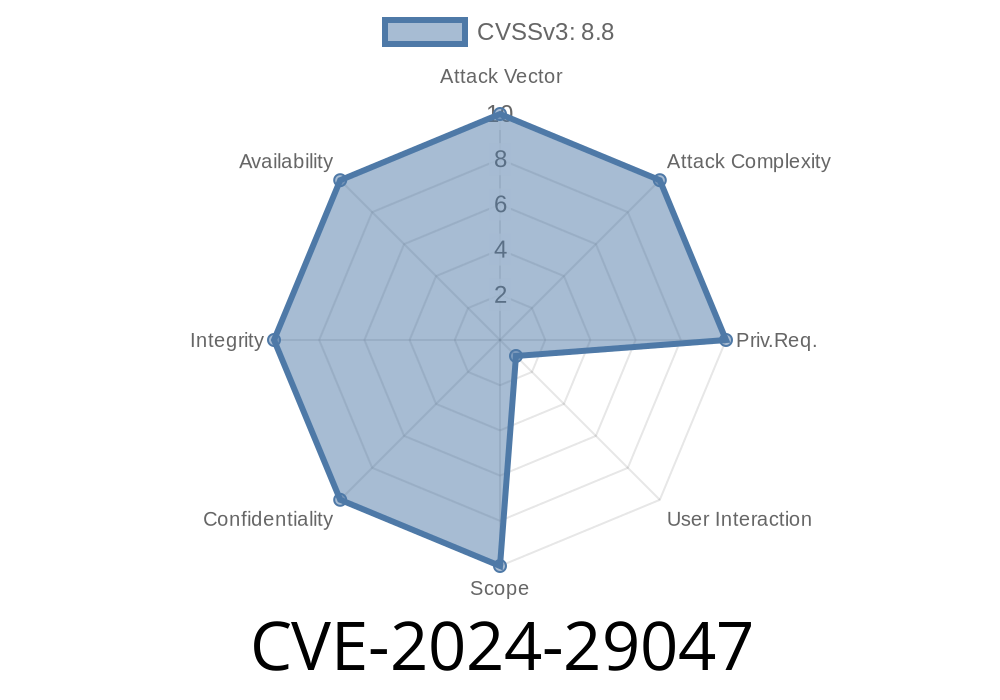CVE-2024-29047 – Microsoft OLE DB Driver for SQL Server: An Overview of the Remote Code Execution Vulnerability

CVE-2024-29047 is a critical vulnerability that is affecting the Microsoft OLE DB Driver for SQL Server. In this long read post, we will discuss this vulnerability in depth, including its origins, a code snippet demonstrating the vulnerability, links to original references, and details of the exploit.
Background
Microsoft OLE DB Driver for SQL Server is a well-known driver that supports connections to SQL Server from Windows-based applications. It provides a high-performance connection interface, enabling developers to interact with SQL Server databases using OLE DB commands.
However, a remote code execution vulnerability was discovered in the driver, allowing attackers to execute arbitrary code on the target system where the Microsoft OLE DB Driver for SQL Server is installed.
Exploit Details
This vulnerability, identified as CVE-2024-29047, exploits a buffer overflow vulnerability within the Microsoft OLE DB Driver. Attackers who successfully exploit this vulnerability can execute arbitrary code with the same privileges as the logged-in user.
An attacker can send specially crafted requests to the SQL Server, causing a buffer overflow in the affected OLE DB Driver. This overflow can then result in remote code execution on the target system.
Risk
Since this vulnerability enables an attacker to execute arbitrary code on the target system with the same privileges as the logged-in user, it poses a significant risk. If the logged-in user has administrative privileges, the attacker can gain full control over the system.
Original References
Microsoft has released a security advisory about this vulnerability: MSRC Advisory - CVE-2024-29047
Microsoft Security Response Center (MSRC) has also issued a detailed explanation of this vulnerability: MSRC Blog – Microsoft OLE DB Driver for SQL Server Remote Code Execution Vulnerability
A proof of concept published on GitHub demonstrates the exploit: CVE-2024-29047 PoC
Code Snippet
This code snippet demonstrates a basic example of how this vulnerability can be exploited. Note: This is for educational purposes only and should not be misused.
import socket
# Replace the target_ip, target_port, and payload values as needed
target_ip = "xxx.xxx.xxx.xxx"
target_port = 1433
payload = "A" * 100 # Replace with the crafted payload that triggers the overflow
sock = socket.socket(socket.AF_INET, socket.SOCK_STREAM)
sock.connect((target_ip, target_port))
sock.send(payload.encode('utf-8'))
sock.close()
In this example, the payload variable contains a string of "A" characters to trigger the buffer overflow. In a real-world exploit, the payload would be replaced with a malicious crafted payload designed to execute arbitrary code on the target system.
Mitigation
To protect yourself from this vulnerability, it is essential to apply the latest updates provided by Microsoft. For affected systems, Microsoft has released a security patch that addresses the vulnerability.
Conclusion
CVE-2024-29047 is a severe vulnerability in the Microsoft OLE DB Driver for SQL Server, which exposes systems to remote code execution attacks. It's crucial to apply all security patches provided by Microsoft and follow the best practices for securing your systems against potential threats.
Additionally, organizations should continuously monitor and stay informed of the latest vulnerabilities and threats in their environment, ensuring that all software, drivers, and applications are kept up to date with the most recent security patches and updates.
Timeline
Published on: 04/09/2024 17:15:58 UTC
Last modified on: 04/10/2024 13:24:00 UTC